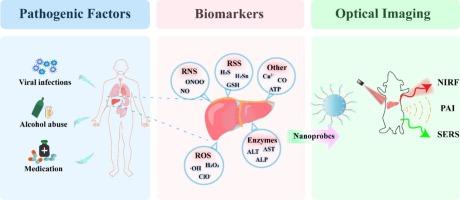基于光学成像技术的纳米探针用于检测肝损伤疾病的生物标记物
IF 20.3
1区 化学
Q1 CHEMISTRY, INORGANIC & NUCLEAR
引用次数: 0
摘要
多种因素导致的肝损伤疾病已引起广泛关注,良好的监测策略在治疗过程中至关重要。在过去的几十年中,包括荧光成像、光声成像和磁共振成像在内的光学成像技术逐渐被掌握并应用于肝损伤疾病的临床诊断和治疗。这些成像技术依赖探针对肝损伤疾病中的关键生物标志物产生响应信号,然后通过相应的仪器对信号进行检测。其中,我们认为具有良好水溶性和生物相容性的纳米探针具有更好的应用前景。在这篇综述中,我们重点讨论了已开发的纳米探针的常见设计策略、靶向生物标记物、检测原理和生物学应用,希望这篇综述能对纳米探针在肝损伤治疗领域的发展有所启发。本文章由计算机程序翻译,如有差异,请以英文原文为准。


Nanoprobes based on optical imaging techniques for detecting biomarkers in liver injury diseases
The liver injury diseases caused by multiple factors have attracted widespread attention and good monitoring strategies are essential in the treatment process. In the past few decades, optical imaging techniques including fluorescence imaging, photoacoustic imaging and magnetic resonance imaging were gradually mastered and applied in clinical diagnosis and treatment of liver injury diseases. Such imaging techniques depend on probes generating signals in response to the critical biomarkers in liver injury diseases, and then the signals can be detected by corresponding instruments. Among them, we consider that nanoprobes with excellent aqueous solubility and biocompatibility have better application prospects. In this review, we focused on discussing the common design strategies, targeted biomarkers, detecting principles and biological applications of nanoprobes that have been developed, and we hope this review can inspire the development of nanoprobes utilized in the field of liver injury treatment.
求助全文
通过发布文献求助,成功后即可免费获取论文全文。
去求助
来源期刊

Coordination Chemistry Reviews
化学-无机化学与核化学
CiteScore
34.30
自引率
5.30%
发文量
457
审稿时长
54 days
期刊介绍:
Coordination Chemistry Reviews offers rapid publication of review articles on current and significant topics in coordination chemistry, encompassing organometallic, supramolecular, theoretical, and bioinorganic chemistry. It also covers catalysis, materials chemistry, and metal-organic frameworks from a coordination chemistry perspective. Reviews summarize recent developments or discuss specific techniques, welcoming contributions from both established and emerging researchers.
The journal releases special issues on timely subjects, including those featuring contributions from specific regions or conferences. Occasional full-length book articles are also featured. Additionally, special volumes cover annual reviews of main group chemistry, transition metal group chemistry, and organometallic chemistry. These comprehensive reviews are vital resources for those engaged in coordination chemistry, further establishing Coordination Chemistry Reviews as a hub for insightful surveys in inorganic and physical inorganic chemistry.
 求助内容:
求助内容: 应助结果提醒方式:
应助结果提醒方式:


